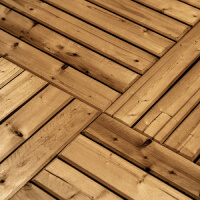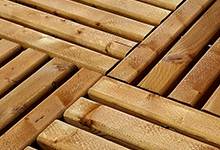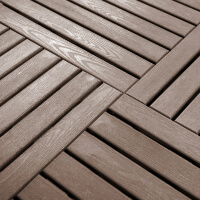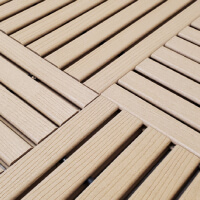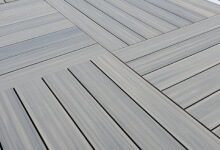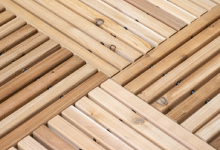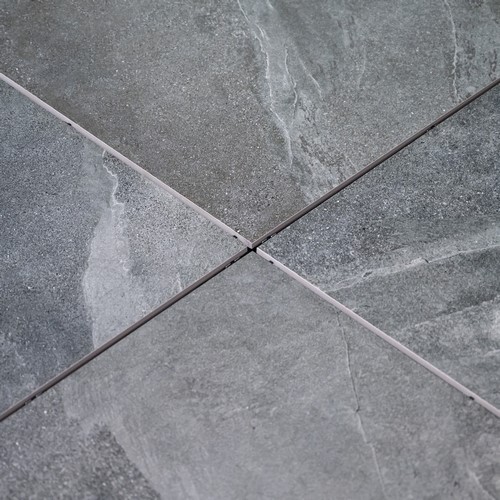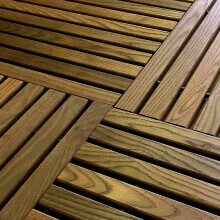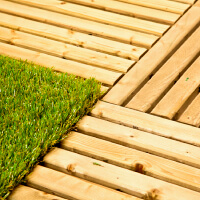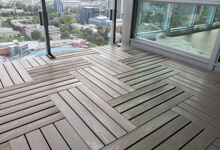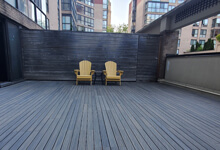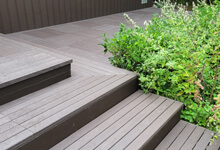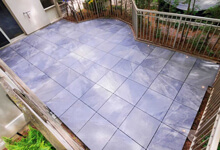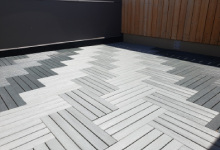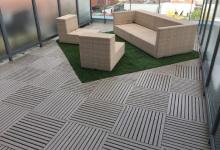Would you like to browse our deck tile products and accessories?

- By: Designer Deck
- Tags: How Do I Accurately Measure a Space for Estimating
- Category: Blog
- 0 comment
For over 30 years, Designer Deck has been at the forefront of the decking industry in Canada, serving as a testament to quality, customer satisfaction, and innovative outdoor solutions. As a family-owned business, we understand the essence of creating a space that not only meets but exceeds expectations. One critical step in achieving this goal, whether for decking, remodeling, or any project requiring precise dimensions, is accurate measurement. Through years of experience, we’ve honed the art of measuring spaces accurately and are here to share this essential guide with you.
Essential Tools for Accurate Measurement
- Tape Measure: Explain why a durable, retractable tape measure is vital.
- Laser Distance Measurer: Introduce technology options for larger or more complex spaces.
- Notepad and Pencil: Highlight the importance of recording measurements.
- Calculator: For quick calculations of area and volume.
Step-by-Step Guide to Measuring Space

When embarking on any home improvement project, accurate measurements of your space are crucial. This step-by-step guide elaborates on how to measure straight lines, tackle irregular spaces, calculate square footage, and determine the volume of a room or outdoor area. Whether you’re planning a new deck with Designer Deck or remodeling your living room, these methods ensure precision and efficiency.
Straight Line Measurements
Measuring the length, width, and height of a space seems straightforward but requires attention to detail for accuracy.
- Length and Width: Place the end of your tape measure at one corner of the room or space. Extend the tape straight to the opposite corner to measure the length. Record this measurement. Repeat the process for the width by measuring the distance between the other two corners. Ensure the tape measure is flat and tight against the surface for the most accurate reading.
- Height: To measure the height, place the tape measure at the bottom of the wall and extend it upwards to the ceiling. If you’re measuring outside, like for a deck, measure from the ground to the desired height of the structure.
Measuring Irregular Spaces
Irregular spaces, such as L-shaped rooms or areas with alcoves, require a bit more strategy.
- Divide and Conquer: Break down the irregular space into rectangular sections. Measure each section as if it were a separate, smaller room, recording the length and width.
- Account for Obstructions: If there are permanent fixtures or built-ins, measure the space as if these obstructions weren’t there to ensure you’re accounting for the total area. You can subtract the space taken up by the fixtures later if necessary.
Calculating Square Footage
Square footage is essential for knowing how much material you’ll need for flooring, decking, or paint.
- For Rectangular or Square Spaces: Find out how much space each part of the area takes up by multiplying how long it is by how wide it is. For instance, if a room is 12 feet long and 10 feet wide, you figure out its area by multiplying 12 feet by 10 feet, which equals 120 square feet.
- For Irregular Spaces: Find the size of each rectangular part you spotted earlier by measuring their length and width. Then, add up these sizes to figure out how much space there is in total.
Calculating Volume
Volume calculation is crucial for projects requiring three-dimensional measurements, like filling a raised garden bed or calculating the capacity of a room for heating or cooling.
- Basic Volume Calculation: Find the size of the space and then multiply that number by how tall it is. Using the previous example, if the room is 120 square feet and has a ceiling height of 8 feet, the volume would be 960 cubic feet (120 sq ft x 8 ft = 960 cubic ft).
- For Irregular Spaces: Find out how much space each part takes up by itself, then put those amounts together to get the total volume. This is particularly useful in attics or rooms with sloped ceilings where height varies.
Tips for Accuracy
- Use a digital laser measure for large or hard-to-reach areas.
- Double-check each measurement.
- Record measurements in both feet and meters to facilitate material purchase and consultation with professionals.
- Always round to the nearest whole number for simplicity, unless precise measurements are critical.
By doing these steps carefully, you can measure any area accurately, which will help you plan and do your project well. Taking your time now can save you a lot of time and money later on.
Advanced Tips and Tricks
Using reference objects can help in tight spots where a tape measure won’t fit. If you encounter obstructions, measure the accessible parts and approximate the hidden dimensions based on the overall space layout. Always double-check your measurements to ensure accuracy.
Common Mistakes to Avoid
Misreading the tape measure is a common error, so familiarize yourself with its markings. Don’t overlook the depth of spaces, especially for projects involving storage or built-ins. Angled walls require special attention; use the Pythagorean theorem or a laser measurer to tackle these challenges.
Applying Your Measurements
Your measurements will guide material estimates and project plans. Whether you’re calculating the amount of decking material needed or determining the size of an outdoor kitchen, accuracy in these initial steps ensures efficiency and cost-effectiveness down the line.
Why Trust Designer Deck?
At Designer Deck, we’ve built our reputation on reliability, customer satisfaction, and quality workmanship. Our extensive experience in the decking industry means we understand the nuances of outdoor space planning and execution. By sharing our knowledge on accurate space measurement, we aim to empower you to start your projects on the right foot, ensuring results that align with your vision.
We believe in creating lasting relationships with our clientele, offering guidance from the planning phase through to installation and maintenance. Our commitment to providing an unforgettable outdoor experience is unwavering, as we continue to innovate and raise the bar in the industry.
Conclusion
Accurate measurement is the foundation of any successful project. By following this guide, you’re setting the stage for a seamless execution, whether it’s a new deck, a renovation, or an outdoor transformation. At Designer Deck, we’re here to support your journey, offering expert advice and quality products made in Canada. Your outdoor space is an extension of your home, and with precise planning and execution, it can become your favorite place to unwind and entertain.



